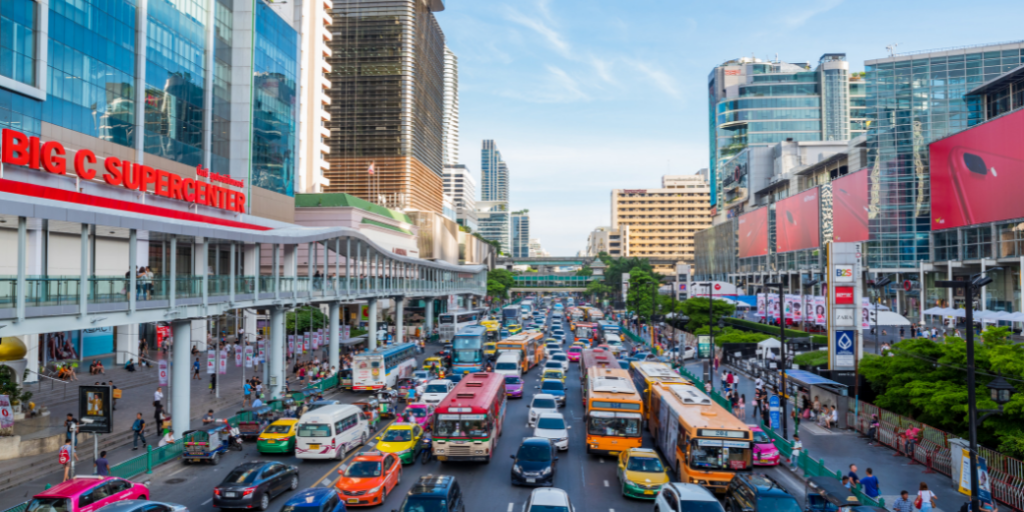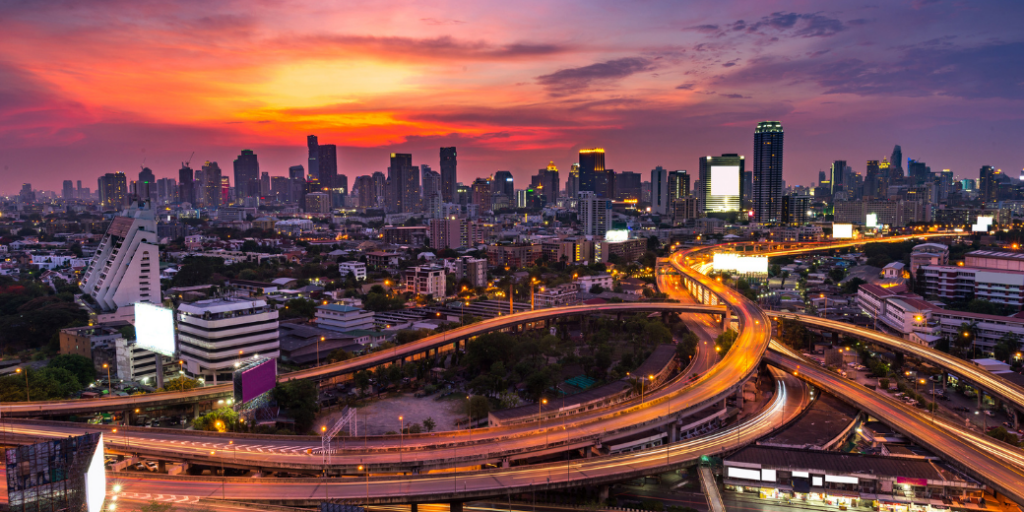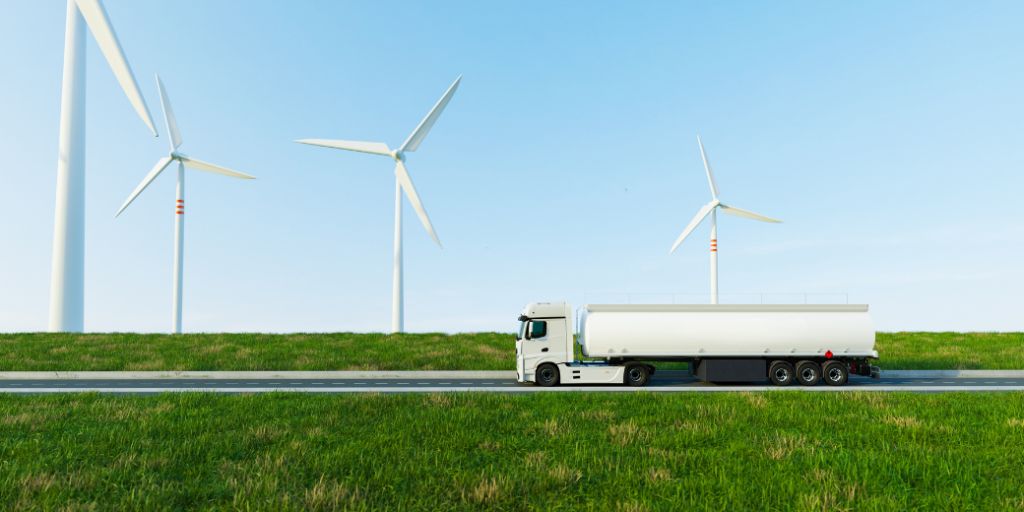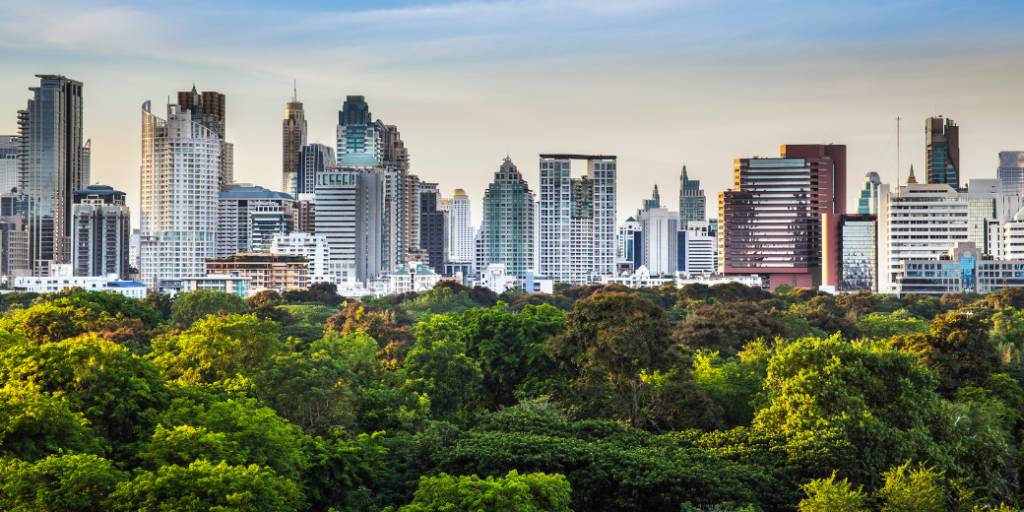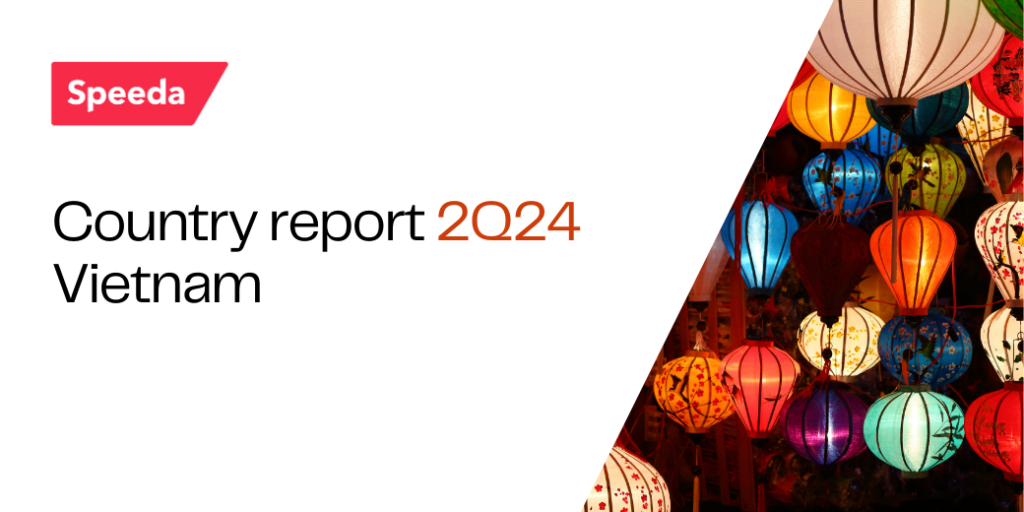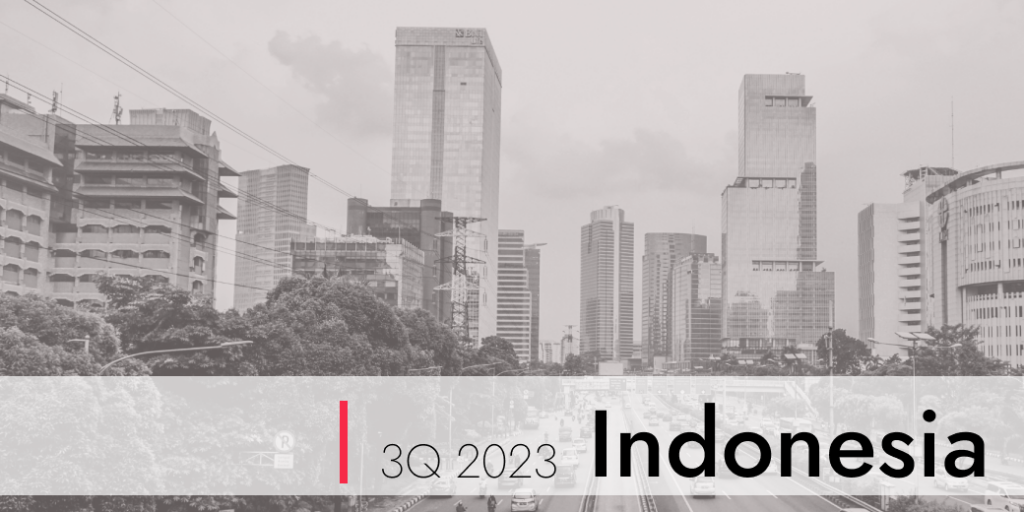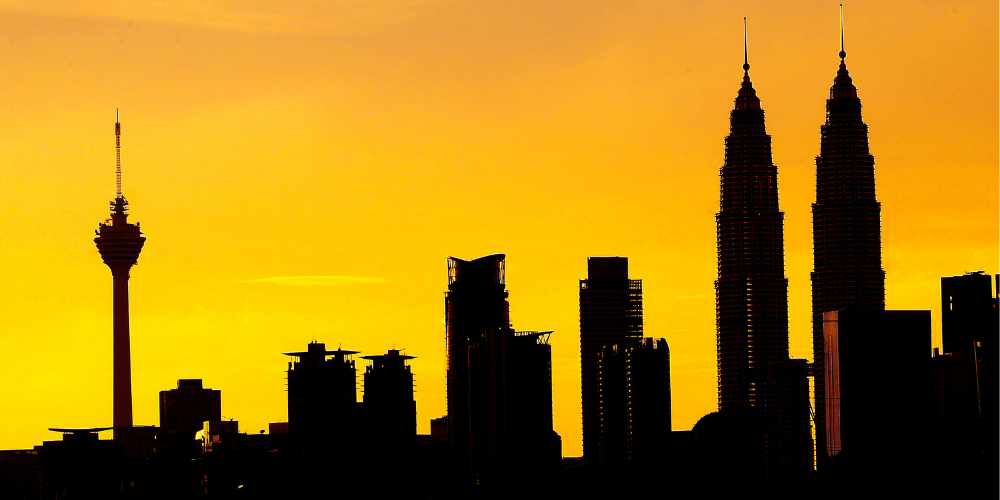Báo cáo Xu hướng
Country Report Vietnam 3Q2023 | SPEEDA
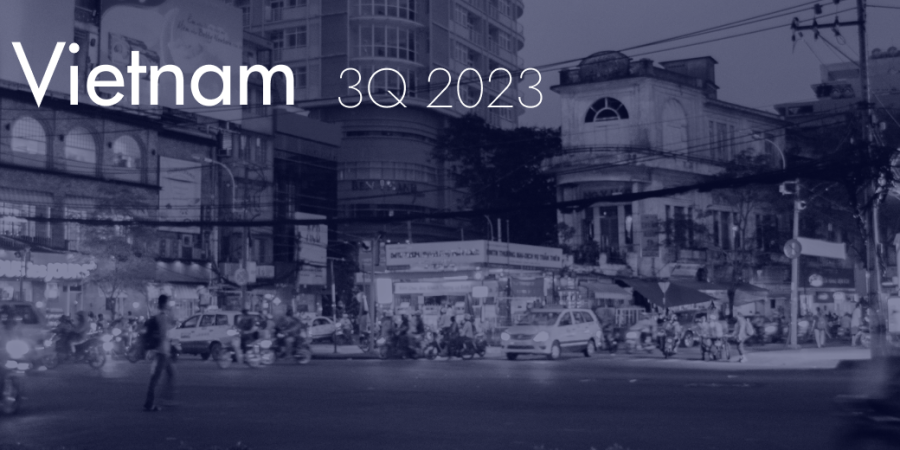
The country report is designed for business corporations, offering insights into the short to mid-term macroeconomic developments of each ASEAN 6 country. The report includes a dynamic PESTLE Analysis performed by our analysts, capturing vital country movements in the past quarter and predicting developments for the future.
Additionally, the report highlights four key industries of interest to our clients – Chemicals, Electronics, Information and Communications Technology (ICT), and Construction – and comprises a section on other emerging industries for the quarter.
Overview
Vietnam is undergoing an economic shift, transitioning from an agricultural-based economy towards a service-based economy. In 9M23, the service sector accounted for almost half of the country’s GDP.
Tourism is a significant strength, with many famous attractions such as Ha Long Bay, Cuc Phuong National Park, Son Doong Cave, and Hoi An Ancient Town. In 9M23, the country welcomed a significant number of international tourists, already exceeding the annual target of international visitors in 2023.
Vietnam is located on the Indochina peninsula in Southeast Asia, bordering China to the North, and Laos and Cambodia to the West. The country’s location offers many advantages in different ways. The long coastline with its tropical monsoon climate proves beneficial for agriculture, fishing, tourism, and easy access to foreign markets. The intersection of Northeast and Southeast Asia allows Vietnam to form multiple trade relations with fast-growing economies, such as Japan, South Korea, China, and India. However, in the context of the ongoing South China Sea dispute, Vietnam bears a risk of being sanctioned by China – its largest international trade partner.
Key Takeaways on Vietnam’s 3Q23
- Economy Size: Vietnam’s real gross domestic product (GDP) remained as the lowest in absolute terms among ASEAN-6 countries.
- Stable Performance: Though GDP growth was below the target, showing steady growth in YOY and drop in unemployment rate.
- International Trade: Maintaining the position as a net exporter with international trade, performing favourably as global economies slowly pick up.
- Economic Growth: Public investment is expected to become a driving force for economic growth.
- Challenges: Corruption remains a concern; however, current anti-corruption efforts are supposedly the most impactful in the history of the Communist Party of Vietnam.
- Consumer’s Behavior: Consumers are becoming value and health-conscious while preferring omnichannel shopping.
Vietnam’s Landscape
Economic Landscape: Despite having the lowest real GDP among ASEAN 6 countries in 3Q23, Vietnam experienced stable growth.
Vietnam’s real GDP in 3Q23 was USD 59.4 billion, the lowest among ASEAN 6 countries. This could be due to Vietnam’s struggle to grow its economy fast enough to narrow the development gap. The country aims to improve labour productivity and bridge the development gap to avoid the middle-income trap.
Despite the struggle with slow GDP growth, the 3Q23 witnessed stable improvement, with a 3.1% increase in real GDP. It is expected that the 4Q23 will experience strong growth of 13.9%. The service sector led GDP contributions, followed by industry, agriculture, and fishing. The annual inflation rate has risen steadily in 3Q23 but stayed below the 4.5% target rate.
The country’s average unemployment rate in 2022 was 2.3%, dropping 0.9% YoY. The country is grappling with the challenges of a quickly ageing population, posing potential burdens on society due to fewer working-age individuals.
Vietnam ranks second in export/import value in ASEAN, relying on telephones, mobile phones, and textiles. In 3Q23, the Manufacturing and Processing sector attracted significant foreign investment, with South Korea as the leading FDI investor.
As of 2Q23, Vietnam was ranked the third-largest recipient of realised FDI. In 3Q23, South Korea reclaimed the leading position as the largest FDI investor in Vietnam, accounting for 21.3% of the country’s total newly registered, additional, and contributed capital. In 2Q23, Japan was the largest FDI investor, followed by China and Singapore.
The country’s public investment is expected to become a pivotal driver of economic growth, particularly with the acceleration of major infrastructure development projects like the North-South Expressway (phase II), the Long Thanh International Airport, and Ho Chi Minh City’s Ring Road III anticipated in 2024.
Technology Landscape: Vietnam is the third-largest digital economy in ASEAN and is expected to record the strongest growth in terms of Gross Merchandise Value (GMV) during 2022-25E.
Vietnam stands out as the third-largest digital economy in ASEAN, projecting robust growth in GMV from 2022 to 2025. The country’s focus on technology extends to Big Data and Data Analytics, ranking first in information technology categories earmarked for state budget allocations in 2023. Additionally, Vietnam leads globally in crypto adoption and holds the second position in ASEAN for crypto holders. The application of Blockchain technology is anticipated in various sectors such as Logistics, Education, Health, and Banking.
Moreover, the technological landscape in Vietnam witnesses a rising trend in the adoption of key applications like Artificial Intelligence (AI), the Internet of Things (IoT), and Cloud Computing. These advancements underscore Vietnam’s commitment to staying at the forefront of technological innovation, shaping its future across diverse industries.
Political Landscape: Corruption remains a major problem in Vietnam.
Corruption remains a significant challenge in Vietnam, with a Transparency International Corruption Perception Index 2022 ranking of 77 out of 180 countries. Despite slow progress, Vietnam’s anti-corruption campaign, led by the Communist Party, stands as the most impactful in its history.
Social Dynamics: Vietnamese consumers are changing shopping habits towards healthy, value-maximising purchases.
Urbanisation in Vietnam is polycentric, with commercial activities concentrated in two major cities: Hanoi and Ho Chi Minh City.
Based on a 2022 McKinsey Vietnam Consumer Pulse Survey, Vietnamese consumers are becoming value-conscious, opting for premium brands in certain categories while reducing purchases in others. Core categories like groceries, fuel, household supplies, and personal care products are seeing increased consumption. Omnichannel shopping has replaced in-store shopping during the pandemic, and this trend is expected to persist. They prioritise healthier and more sustainable choices in discretionary categories related to health and wellness, but environmental protection remains a lower priority.
Environmental Focus: Vietnam is Committed to Achieving All SDGs by 2030.
According to the Sustainable Development Goals Index (SDG) 2022, Vietnam ranked 55 out of 166 countries with a total score of 73.3 points and ranked second among ASEAN countries. Vietnam is still strongly committed to achieving all the SDGs by 2030. To work towards these goals, the government issued Notice No. 85/TB-VPCP on March 23, outlining the proposed plan for implementing Vietnam’s SDGs by 2030.
Legal Landscape: Vietnam offers multiple tax incentives to encourage investment and business activities.
Vietnam actively promotes investment and business activities through a comprehensive array of tax incentives.
Moreover, the tax incentives in Vietnam extend to various sectors and locations, such as education, healthcare, high technology, and designated economic zones, fostering a favourable environment for investors. These incentives encompass tax holidays, inbound investment advantages, employment incentives, and the establishment of research and development funds. The government’s commitment to encouraging economic activities is further exemplified by the anticipation of a Value-added tax (VAT) reduction from 10.0% to 8.0% in mid-2023, aiming to stimulate consumption and support sustained economic growth.
Additionally, labour laws are continuously refined to align with global standards as the country attracts increasing foreign investment.
Industry Spotlight
The industry spotlight focuses on Vietnam’s leading and emerging sectors, offering a brief overview of the country’s industry landscape that drives current growth and future potential.
Leading Sectors in Vietnam
Electronics
The electronics sector accounts for 17.8% of Vietnam’s industrial production value, placing the nation among the world’s top 15 largest electronics exporters. Vietnam’s most exported products are computers, electronic products, and components. Vietnam’s policies set out to become a regional hub for semiconductor and technology production. In the period of 2020-2025E, priority is given to computers and phones, which will shift to software, digital content, medical information technology, and electronic services after 2025.
Despite the strong potential, the electronics sector in Vietnam still heavily relies on foreign direct investment, with low localisation and high labour-intensive rates.
Chemicals
Vietnam’s chemical sector is in a nascent stage and focuses on producing basic chemicals. Businesses mainly produce fertilisers, followed by plant protection chemicals, basic chemicals, and petrochemical products. Industrial chemicals produced domestically fail to satisfy local demand and are only sufficient to produce pesticides and other basic products.
In 7M23, Vietnam’s chemical import and export turnover declined, emphasising economic recession risks cutting back on production. China remained the largest exporter of chemicals to Vietnam, accounting for 37.5% of Vietnam’s chemical import turnover in the first 7M23.
Information and Communication Technology (ICT)
Vietnam emerges as a tech startup hub, with persistent growth expected in 2023. Key focuses include 5G commercialisation, combating spam calls, and hosting digital technology enterprises, contributing a significant amount to the GDP by 2025.
Construction
Vietnam’s construction sector remains a focal point for foreign investors. With a surge in industrial and commercial real estate, it continues to contribute substantially to the nation’s economic development.
Emerging Industries in Vietnam
Tourism
Vietnam’s rich cultural heritage and natural beauty fuel its rapid tourism growth. By 9M23, it welcomed a considerable amount of international tourists, surpassing the annual target for 2023. New policies granting e-visas and extending the duration of stay for certain countries boosted the industry as well.
Energy
Vietnam is positioned as one of Asia’s fastest-growing energy markets, with the country’s power consumption expected to grow 10-12% annually until 2023. Diverse energy sources are pursued, with a focus on coal-fired power and hydropower, alongside an increasing emphasis on renewable energy.
Healthcare
Vietnam’s economic development and rising middle-class drive demand for high-quality healthcare services. Healthcare spending is on the rise, reaching USD 20.0 billion in 2021. The development of the “smart healthcare” sector opens more opportunities for foreign investors.
Manufacturing
Benefiting from cheap labour and trade agreements, Vietnam’s manufacturing industry, particularly in electronics, textiles, and machinery, attracts foreign investment. While international tech companies expand operations, challenges persist in adopting smart manufacturing practices among smaller firms.
Thank you for your submission!
We will send an email with the download link to access the report shortly.
Theo dõi trang LinkedIn của chúng tôi!
Chúng tôi sẽ đăng các báo cáo mới nhất về
ASEAN và thông tin về các hội thảo trực tuyến tại đây.


